The Love Letter
c. 1667–1670Oil on canvas
44 x 38.5.cm. (17 3/8 x 15 1/8 in.)
Rijksmuseum, Amsterdam
The subject of the love letter, the view into adjacent rooms, and the presence of elements such as the lute, broom, clogs (fig. 1) and map on the door are found in numerous paintings of interiors and demonstrate the contacts which existed between Vermeer's art and that of his contemporaries.
The subject of this painting is love. This is evident in the presence of musical references (the instrument held by the woman and the musical score on the chair in the foreground) which were commonly used as a metaphor for harmony between two people and the letter which the young woman holds, undoubtedly from a loved one whom she speaks of with the servant. The painters of interior scenes often included paintings within paintings to clarify the meaning of the composition. In this case the paintings on the end wall, a landscape with a man and woman and a seascape, undoubtedly refer to the absence of the loved one, as in Metsu's painting A Lady Reading a Letter.
During the last phase of his career, from 1669 about until his death in 1675, Vermeer's paintings reveal a greater tendency towards an abstraction of the forms and less attention to detail than in earlier works, as evident here. One feature which has remained constant is his skill in controlling the relationship of the spectator with the painting through the construction of the space. In this work the orthogonals which coincide with the lower part of the map in the foreground, the tiles on the floor, the stringed instrument and the broom, converge on a point in the room in the foreground, above the chair. Vermeer thus momentarily obstructs our gaze as it attempts to focus on the scene in the rear. The broom has the same function, as do the wooden shoes which obstruct the access between the two rooms. The fact that it is difficult for our gaze to penetrate to the figures at the rear makes us feel like intruders in an intimacy to which we have not been invited. In this sense, this painting summarizes a key aspect of all interior painting, the pleasure arising from the possibility of looking in on the private life of others.
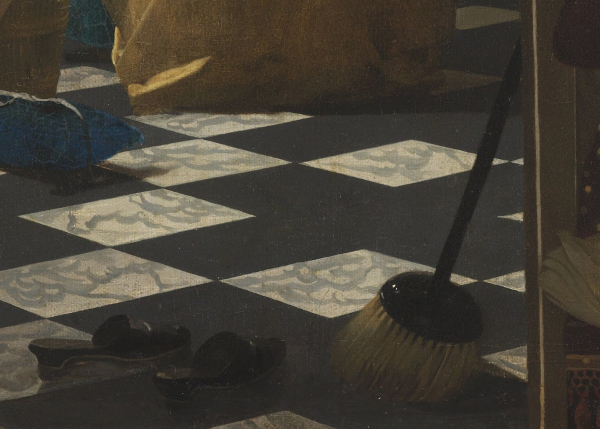
Johannes Vermeer
c. 1667–1670
Oil on canvas, 44 x 38.5.cm.
Rijksmuseum, Amsterdam
The composition of this painting is undoubtedly based on a work by Pieter de Hooch, A Couple with a Parrot (fig. 2) which develops ideas that appear in earlier works by Van Hoogstraten and other artists. While both De Hooch and Vermeer set their figures in a space behind a doorway which we see from a dark, adjoining room, the manipulation of the perspective space in Vermeer's painting subtly increases the sense of intrusion.
In his mature work Vermeer does not often deal with action and anecdote. Yet they are not entirely abandoned; however foreign to his temperament the habitual subjects of genre painters, the lively movement of the world retains a fascination that is not easily forgotten. Once at least, as Vermeer's development passes its climacteric, the suspended animation of his pictures is near to being let loose. But the release is characteristically ambiguous. The movement of life is recorded with a startling brilliance and then the whole perverse complexity of the painter's artifice is invoked to soften and deflect its impact. Among the pictures that we have none is more elaborately or more curiously calculated than the little Love Letter.
Vermeer's facility rarely extended to inventiveness. In the consideration of his later works the paradox becomes clear that even when their evident refinement was already exercising a considerable influence on his associates Vermeer himself remained dependent on earlier pictures for the fundamentals of his motifs. One of his lost pictures seems to have contained a vista into another room but whatever has disappeared it is doubtful if it could more than slightly modify the impression that Pieter de Hooch was primarily responsible for evolving the device of the doorway as a genre motif. It is a feature of his typical compositions throughout his career. But the form in which it appears in The Love Letter is a highly personal one. There are examples of similar compositions in the painting of Delft which can hardly have been due to the influence of Vermeer's picture; possibly the device was in general use. It is nevertheless clear that the paradoxical quality of this arrangement is Vermeer's own. De Hooch himself imitated it in a picture of an elegant incident involving a parrot (fig. 2).
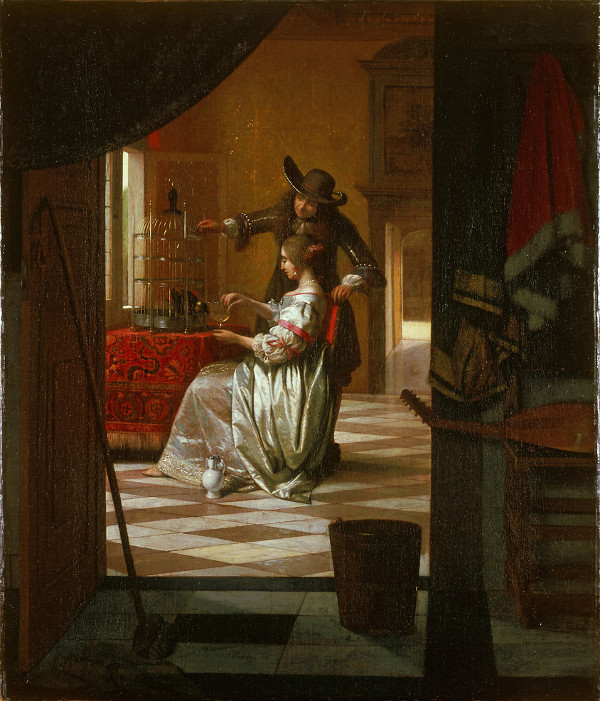
Pieter de Hooch
c. 1668
Oil on canvas, 73 x 62 cm.
Wallfar-Richartz-Museum, Cologne
Elise Goodman
 "The Landscape on the Wall in Vermeer"
"The Landscape on the Wall in Vermeer"The Cambridge Companion to Vermeer (Cambridge Companions to the History of Art)
2001, pp. 76–78
The mood is no less lyrical (than in the Glass of Wine), but it appears to have a nostalgic rather than an anticipatory thrust in the two paintings on the wall of The Love Letter. A solitary wanderer appears in the idyllic landscape (fig. 3) in the mode of Adriaen van de Velde (1636–1672) hung above a seascape with a ship.
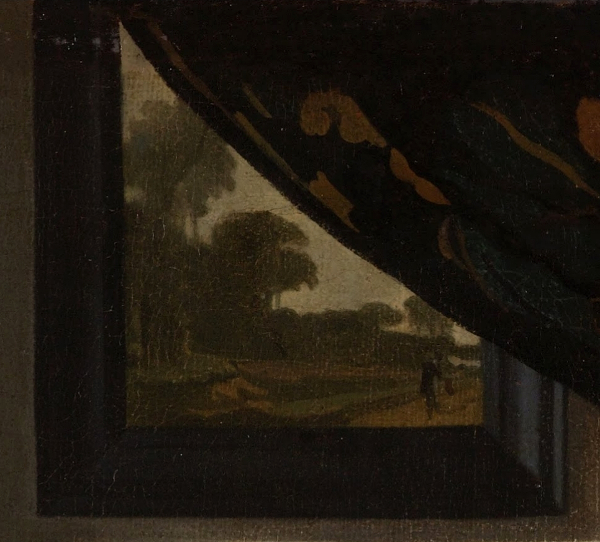
Johannes Vermeer
c. 1667–1670
Oil on canvas, 44 x 38.5.cm.
Rijksmuseum, Amsterdam
The wanderer in the forest forms a vertical with the female lutenist below in Vermeer's painting itself. This arrangement probably reflects the double motif of the separation of lovers and their desire for reunion. Vermeer seems to have portrayed their relationship through the topos, widespread in poetry and songs, of the exiled lover who confides to nature his wish to return to his lady In love lyrics of the Petrarchan tradition and in the lute songs they inspired, nature was depicted as a sympathetic witness to the lover's pains and hopes during his absence from the beloved. This motif of the exiled suitor's sufferings in nature (about which an entire book has been written) appeared, for example, in Constantijn Huygens's air for solo voice and lute entablature, published in the Pathodia Sacra et Profana (Sacred and Profane Songs of Suffering) of 1647:
Grave witnesses of my delights,
Do not expect me any longer to go
Bushy oaks, lovely precipices,
For somany summers,
Jealous and proud of my happiness.
Anywhere except where Love beckons me…
In a similar melancholy tenor, the exiled lover in Hooft's "Sang" (1612) intones his frustrations:
Does anyone wonder who makes my voice ring?
Tis One without whose grace
No impulse within my frame grows strong,
For whom my voice I raise
Till the level sands and the streams around
And the hills reverberate and resound.
The theme of absence and the desire for reunion is underscored by the seascape (fig. 4) below the solitary peregrinator. As art historians have noted, the ship in the picture is associated with the emblematic motif of the suitor as a ship on the sea of love searching far the safe harbor of his lady's arms. Jan Harmensz. Krul's emblem (fig. 5), which has been connected to The Love Letter, is superscribed by a motto that reinforces the theme of exile from love: "Even Though You Are Far Away, You Are Never Out of My Heart." Vermeer supports the topos by the letter, presumably a loveletter, that has been delivered to the lady with the lute.
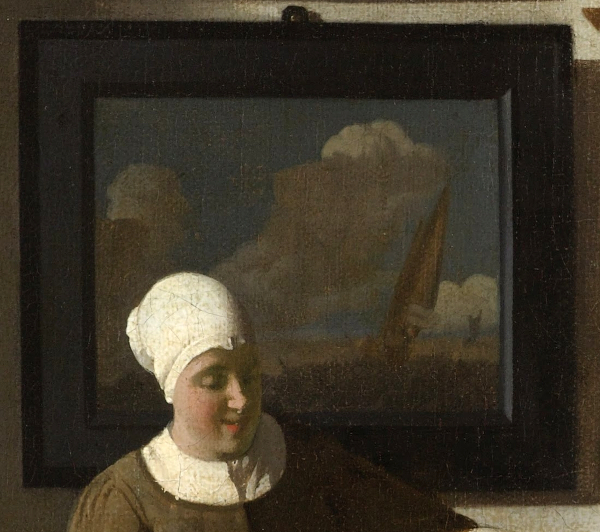
Johannes Vermeer
c. 1667–1670
Oil on canvas, 44 x 38.5.cm.
Rijksmuseum, Amsterdam
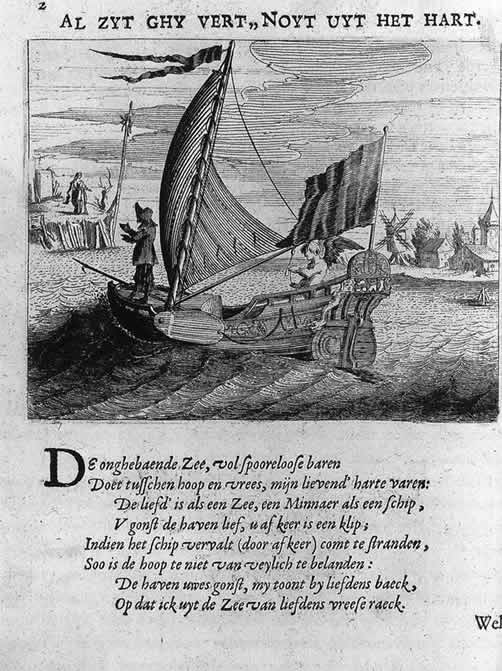
Dedicated to Amorous Youth
Jan Harmensz Krul
Amsterdam 1640.
The See-through Door
The most striking feature of the present work's composition is the shadowed doorway in the foreground to enhance the painting's perspective. A darkened aperture in the immediate foreground combined with a lighted view in the distance was a popular device for enhancing the illusion of spatial relief. It was used, for example, by the master of illusionism and perspective, Samuel van Hoogstraten, in his painting of 1658 in the Musée du Louvre (fig. 6). Although a figureless interior, that work also employs the darkened foreground with threshold and tiled floor and even shares common motifs with the present work, such as the broom and slippers. The Louvre painting has been cited as a possible source for Vermeer's Woman Asleep, which undoubtedly predates the present work and is the master's only other surviving painting to use a doorkijkje, or view to an adjoining space. (A painting in the Dissius sale in 1696 was described as depicting "a gentleman washing his hands in a see-through room with sculpture.") This device is more commonly and rightly associated with Pieter de Hooch, who probably influenced the younger Vermeer when they were together in Delft.
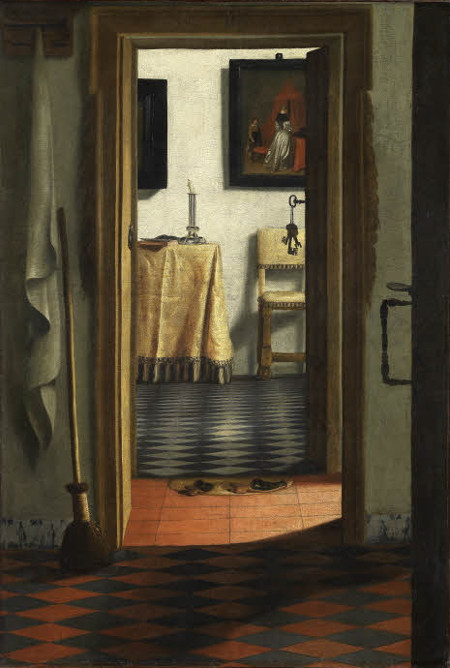
Samuel van Hoogstraten
Between 1654 and 1662
Oil on canvas, 103 x 70 cm.
Louvre, Paris
De Hooch's Couple with a Parrot employs a composition very similar to that of The Love Letter. Indeed, the two paintings must be related, indicating that the artists remained in contact even after de Hooch moved to Amsterdam. The de Hooch has been mistakenly assumed to be dated 1668, but it is in fact undated, and may have been executed after the present work, suggesting that the direction of influence between the two colleagues may have been reversed later in their careers. The authors of the Vermeer exhibition catalogue observed in connection with the present work that Pieter Teding van Berckhout, who visited Vermeer in 1669, observed, "the most extraordinary and curious aspect [of his art) is in the perspective."They also suggested that the visual contrast between the darkened and somewhat unkempt foreground and the tidier lighted distance (a juxtaposition that they found "unsettling") may have a bearing on the painting's expressive message.


